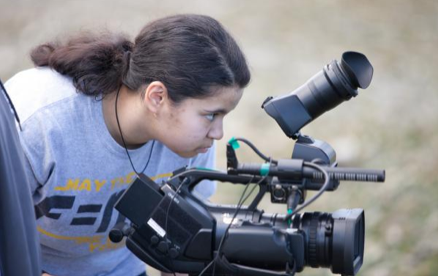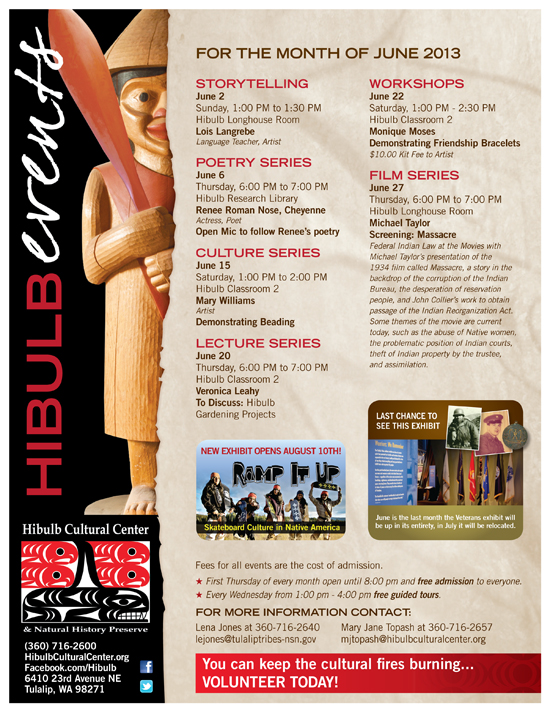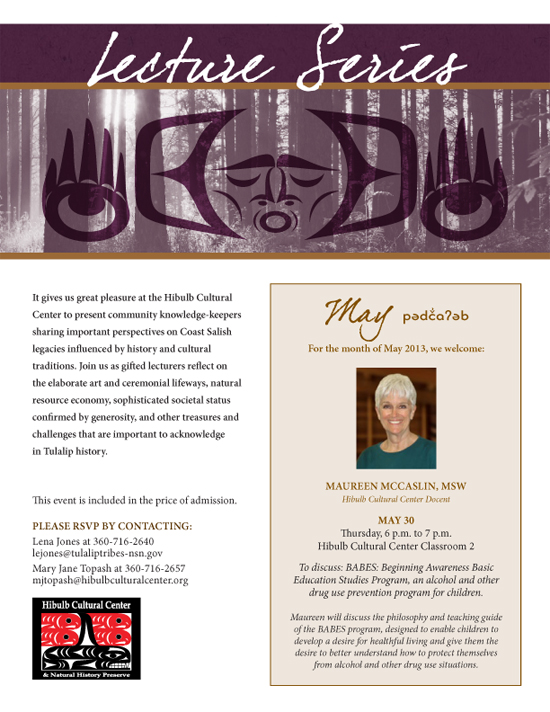Category: Education
Heritage High School graduation photos
Heritage High School of Tulalip held its graduation for the class of 2013 on Saturday. Click here to see a gallery of photos from the ceremony.
More graduation photos
Herald photographers are shooting photos from most Snohomish County high school graduation ceremonies this year. Look for more on our graduation galleries page.
Share your photos
Taking your camera to graduation? We’d love to see what you’ve got. Share your photos and see what others have posted in our reader galleries.
Teens making films ‘on the fly’ out in Indian Country

Raven Two Feathers of Seattle directs a short documentary about the Suquamish Indian tribe as part of the 2013 SuperFly Filmmaking Workshop.
KPLU 88.5 June 7, 2013
Each year, 50 teens from all over the country fly into Seattle to participate in a fast-and-furious film challenge. They have to produce short films in 36 hours, or “on the fly.” Which is why the program is called “SuperFly.”
Most of the participants are Native Americans, creating Native-themed films out on location on an Indian reservation.
Seattle filmmaker Tracy Rector and her Longhouse Media company launched the workshop 8 years ago.
“Growing up in Seattle as a mixed race woman who’s indigenous, I was very aware that there were not representations of people like me. And I often felt very isolated,” she said.
The all-expenses paid workshop, held in partnership with the Seattle International Film Festival, brings together a multi-cultural group of youths. And in an effort to demystify Indian Country, the workshops are held on a different Indian reservation each year.
This year, the Suquamish Tribe out on the Kitsap Peninsula hosted the teens and introduced them to their history and culture through songs, dances, teachings, and a feast of traditional foods. They also inspired the subjects for five short documentaries and one animated film. In previous years, the teens have worked off of original narrative scripts authored by a Native writer.
On the beach on a recent day, Raven Two Feathers and Evodie Ngoy helmed the camera to tell the story of Suquamish tribal member Peg Deam.
Deam stirred up controversy a few years ago when she took a canoe from the Suquamish museum and paddled it out on the water. She says it was her way of reclaiming and revitalizing her culture.
Raven, 16, is Cherokee, Seneca, Cayuga, Comanche, and a New Mexico transplant who now attends Ballard High. She said the workshop taught her more about the diversity of tribes in the Pacific Northwest.
She added she could relate to the subject of her documentary: “I feel like you need to take risks cause originally I was super shy as a kid and I had this one teacher that pushed me to get out of my comfort zone.”
When she stood out on the beach, directing, Raven was anything but shy. She shared directing duties with Evodie, a 15-year-old from Baltimore originally from the Democratic Republic of the Congo.
“It feels awesome. I don’t know how else to express it. I’m mean, too pumped. Too pumped. Too much joy,” she said about the filmmaking experience.
The teens are divided into teams. They work with professional mentors and professional equipment. They’re fueled by the adrenaline of an intense deadline and the passion of what they’ve already figured out they love to do.
“I heard a great thing from a director once that you don’t say, ‘I want to become a filmmaker.’ You say, ‘I am a filmmaker!’ So I guess you could say I am a filmmaker!” said Raven.
“You are! Did you see what you did today?” said Evodie to Raven.
The SuperFly films, which get screened as part of the Seattle International Film Festival, will also get submitted to other festivals. They’ll also wind up in the collection of the Smithsonian’s National Museum of the American Indian in Washington, D.C.
Misdirected Indian Education
Indian Country Today Media Network
About two and a half centuries ago, Northeastern Indian leaders chided American colonial educators for wasting their young men’s time in giving them a European education. The young men who attended colonial schools returned with no relevant skills to hunt. They could not run or take care of themselves in the wilderness. They did not fit into tribal communities. They tended to break down into depression and drink. As a result, the Indian leaders refused to send them to such schools any longer. Instead, they suggested that the colonists send some of their young European men to be educated among Indians.
Some 250 years later, that defiant gesture is still relevant.
In general, education as it is promulgated by those who swept over this country from Europe has been, and continues to be, grossly misdirected for Indian nations and individuals. Its emphasis has almost always been on individual achievement, higher personal income, and jobs and economic opportunity within the non-Indian national market. In other words, it’s all about individual assimilation.
That’s tragic, because education has long been a high priority topic for many Indian communities. There is considerable published research about educating Indian students. However, most of that research focuses on personal success, getting a job, moving out of poverty, and entering the middle class. Those goals are not bad in and of themselves. In many ways, in fact, they may even be commendable. But their problem is that they foster intellectual and economic goals that do not center on tribal communities or their economic and political futures.
As is well known by now, public schools simply do not teach Indian students about tribal nations, Indian policy, or the history of tribal peoples in North America. Even Bureau of Indian Affairs schools do not offer curricula or course content about the organization and operations of tribal government or the meaning of tribal sovereignty. Nor do public and bureau schools train students in local history, the meaning of land, the future issues and problems confronting tribal nations and myriad other subjects.
It doesn’t take a genius to realize that if schools set themselves the task of turning out workers for the American job market by creating national citizens, then they are not doing much in the way of creating tribal citizens. It doesn’t take a genius to realize, either, that a population of thoroughly American citizens and workers will not uphold or sustain tribal goals, culture and self-government.
So where can we look for hope if misdirected Indian education is failing to produce generations of students who are willing and able to serve tribal communities and cultures through a shared appreciation of collective tribal goals and values? We can’t simply rely on elders and tribal knowledge, neither of which are accorded a primary role in the teaching of Indian students. Nor can we afford to wait and cross our fingers that things will get better. With every day that passes, Indian students are not taught sufficiently, and they get one step nearer to graduation with few usable skills to serve them as adults.
There is no alternative. Appropriate education simply must be a key element in Indian nation renewal. Students must be taught to support the values and goals of tribal communities, and at the same time develop the skills that will enable tribal communities and individuals to compete in present-day national and world markets. It is up to American Indian communities to regain control over the education of their children, and schools are obliged to serve the national renewal projects of tribal nations and cultures.
The stakes are too great. Not training students to participate and contribute to tribal nations undercuts tribal efforts for sustained and broad tribal renewal and continuity. A new Indian education system should aim at fostering highly instructed Indian students who are deeply grounded in tribal culture understanding and who are equipped to meet and overcome the challenges that tribal nations will have to reach their goals of cultural, political and economic sustainability.
Read more at https://indiancountrytodaymedianetwork.com/2013/06/05/misdirected-indian-education-149521
Fun, educational events happening at Hibulb this month
Everett Community College Graduation is June 14
EVERETT, WA – Everett Community College will celebrate graduating students and honor outstanding graduates at the EvCC 2013 Commencement at 7 p.m. June 14 at EvCC’s Student Fitness Center.
Doors open at the Student Fitness Center, 2206 Tower St., at 6 p.m. Admission is by ticket only.
EvCC’s Henry M. Jackson Conference Center will be available as an alternate viewing location for those without tickets. For the first time, graduation will also be streamed live on the web from 6:30 to 9:30 p.m. June 14. Go to www.everettcc.edu/graduation and click on watch graduation live.
In 2012-13, more than 2,200 students will graduate from EvCC with a degree or certificate. About 350 students are expected to participate in commencement including student speaker Raven Conyers.
Conyers, a 2011 Cascade High School graduate, was diagnosed with Guillain-Barrè syndrome at age 16. The muscle disorder left her with nerve damage in her hands and feet. Since then, she’s had a strong interest in learning about how the human body works.
At EvCC, Conyers has been involved as a student leader, serving as the Diversity and Intercultural Awareness Coordinator for 2012-13 and as a student senator. She was a member of the Achieve the Dream Start to Finish committee, Student Involvement committee, Awards Banquet committee, Safe Zone committee and Appointment Review committee.
She graduates from EvCC with an associate in arts and sciences degree and is transferring to Washington State University to major in biochemistry and pre-pharmacy with plans to become a pharmacist.
EvCC will also honor 24 outstanding graduates chosen by faculty. (See below).
Outside food and drinks, helium balloons, strollers, car/baby seats, tripods and air horns are not permitted in EvCC’s Student Fitness Center. Limited reserved ADA seating and wheelchair accessible seating will be available. For hearing impaired guests and graduates, sign language interpretation will be provided, and FM machines will be available at the Guest Services Counter at the main entrance.
For more information, visit www.everettcc.edu/graduation or contact Jennifer Rhodes, director of EvCC’s Student Activities Office, at 425-388-9509.
Everett Community College’s 2013 Outstanding Graduates
Faculty members nominate and select outstanding graduates in each of the college’s instructional divisions. Outstanding graduates are recognized with an “Honor for Excellence” gold medallion and a certificate of award.
Maria G. Anakotta, Human Services, Everett
Rachel E. Austin, Adult Ed/Academic Transfer, Everett
Kathy L. Bansen, Medical Transcription, Big Pine Key, Fla.
Jacqueline Nichole Brewer, Early Childhood Education, Snohomish
Aaron Britton, Criminal Justice, Lake Stevens
Charvette Costa, Communications Studies, Marysville
Colby J. Droullard, Social Sciences, Snohomish
Rebecca S. Flippen, Photography, Marysville
Sharlyn K. Galvez, Education, Lake Stevens
Justin W. Gilkison, Manufacturing Tech: CAD, Sultan
Manjeet Singh Hayer, Adult Education, Everett
Karli I. Hesselman, World Languages, Arlington
Jennifer L. Hunsaker, Medical Assisting, Lake Stevens
Dorothyann C. Johnson, English, Everett
Lubna M, Khalfe, Mathematics, Marysville
Kristen J. Marberry, Geology, Lake Stevens
Nicole R. Mather, Accounting, Everett
Kathleen K. McCraw, Medical Coding, Edmonds
Dan A. Radion, Engineering, Arlington
Elizabeth L. Roberts, Business Technology, Mill Creek
Bryant Sales, Studio Arts, Marysville
Matthew W. Spah, Computer Science, Arlington
Adam R. Sylvester, Academic Transfer, Marysville
Kirin M. Vreeland, Pre-Nursing, Everett
CSUSB to Aid in Preservation of Serrano Language Through Course Offering
Kenneth Shoji, San Manuel Band of Mission Indians
SAN BERNARDINO, Calif. – The ancient Native American language of Serrano, which was dying out as fewer and fewer native speakers of the language remained, has received a lifeline through the work of tribal people and academics.
The San Manuel Band of Mission Indians (Yuhaviatam Clan of Serrano) signed a historic agreement with Cal State San Bernardino on Friday, May 24, to have the Serrano language taught at the university by San Manuel linguists and a tribal elder through CSUSB’s world languages and literature department.
“Serrano is a language that came close to extinction,” said CSUSB President Tomás D. Morales. “Now through this agreement, the Serrano language will not only be perpetuated, but also its use will be expanded.”
Under the agreement, San Manuel’s Serrano Language Revitalization Project staff will teach the Serrano language course series – Serrano 101, 102 and 103 – at Cal State San Bernardino for the academic year 2013-2014, in collaboration with Ernest Siva of the Dorothy Ramon Learning Center. The course will cover the language, history and culture of the Serrano people. Along with CSUSB students, tribal citizens also will be able to take the Serrano course series through the university’s College of Extended Learning and receive college credit.
And, as part of the agreement, the tribe’s sponsorship in providing the instructors and curriculum for the course will be considered as a donation to the CSUSB Philanthropic Foundation.
“As we increasingly become an academic center that supports and encourages tribal heritage, we want to continue to build our relations with our native partners,” Morales said. “We want the tribal members of the San Manuel Band of Mission Indians to feel CSUSB is their home. We also want to extend that feeling of welcome to other tribes in our region.”
“It is my belief that our identity as Serrano people is rooted in our land, our culture and our language, each an aspect of the Serrano world connecting us to all that has passed before and all that is yet to come,” said San Manuel Chairperson Carla Rodriguez. “This course will allow Serrano Indian people and Cal State San Bernardino students an opportunity to bring new life to our ancient and sacred language.”
The Serrano Language Revitalization Program, a function of the San Manuel Education Department, conducts regular, ongoing research to develop and publish Serrano resources, including a dictionary and grammar book. This process includes weekly field work with Ernest Siva and is directed by San Manuel Tribal Members, including Education Committee Chairman Paakuma’ Tawinat, who helped lead the tribal effort to establish the Serrano language course series.
“By being involved in the community through our educational outreach, San Manuel has found opportunities and partners to bring new vitality to the Serrano language and culture. On the reservation, we have made great strides to take a traditionally only-spoken language and create a modern written language,” Tawinat said. “The Serrano language is a very important part of our lives, and along with our traditions, it defines who we are as people. It is a great honor to share our language with students, to see it grow and preserve the memory of our ancestors.”
Siva, who has also taught prior courses on culture and language at CSUSB, agreed. “I’m honored to be involved in making the language available to anyone who wants to learn it. It’s kind of like a dream,” he said. “Who’d ever think it would happen?”
Siva grew up on the Morongo Indian Reservation, where he learned the Serrano language and serves as tribal historian and cultural adviser for the Morongo Band of Mission Indians. Siva, who has been a strong proponent for the preservation of American Indian culture, founded and serves as president of the Dorothy Ramon Learning Center, which saves and shares all Southern California’s American Indian cultures, languages, history, music and other traditional arts.
Siva earned both a bachelor’s and master’s degree in music education and choral music from the University of Southern California and serves as a distinguished guest artist in Native American culture at Cal State San Bernardino. Siva also serves on the board of directors of the California Indian Storytelling Association, the board of trustees of Idyllwild Arts, and the board of the Riverside Arts Council. He also is a member of the CSUSB Philanthropic Board of Directors and recipient of an Honorary Doctorate of Fine Arts from the university in 2009.
Morales said the university’s courses on cultural resource management, museum studies, geography and archaeology will focus on maintaining Native American cultural identity and protecting tribal autonomy to further cement the university’s commitment to work with American Indian tribes in the region.
The agreement is another part of the university’s ongoing effort to preserve Native American records.
Over the past year, Thomas Long, an associate professor in the CSUSB history department and its coordinator of public history and internships, has had his students digitize and catalogue the Mission Indian Federation records at the National Archives.
Long’s students also have been digitizing and cataloguing the St. Boniface Indian School records at the San Bernardino Roman Catholic Diocese archives. The archiving project will run through the summer and fall quarter of 2013. At its conclusion, a full copy-set of the materials will be delivered to the San Manuel archives.
In addition, Long’s students have been completing their internship work at the Dorothy Ramon Learning Center, working on various projects aimed at the Serrano and Cahuilla culture preservation as well as other significant archival projects with tribal elder Ernest and his wife, June Siva.
Visit the Dorothy Ramon Learning Center website at
www.dorothyramon.org for more information, as well as the San Manuel Band of Serrano Mission Indians website at http://www.sanmanuel-nsn.gov/.
For more information on Cal State San Bernardino, contact the university’s Office of Public Affairs at (909) 537-5007 and visit news.csusb.edu.
Hibulb Lecture Series Presents Maureen McCaslin, Tonight
Science EXPO Day, June 8
Join Us At Science EXPO Day!
June 8, 2013 – Seattle Center
10 a.m.-6 p.m.
Admission is Free!
Science EXPO Day is a festive, one-day event featuring over 150 booths, activities, demonstrations, and performances that celebrate science, technology, engineering, and math (STEM) and show how integral they are to the region’s culture and prosperity. In addition to Science EXPO Day, Seattle Center will host the Seattle Mini Maker Faire and the Pagdiriwang Philippine Cultural Festival.
Program Highlights
Science EXPO Day is filled with fun and educational programs, including over 150 engaging exhibits, an introduction to Geocaching, the 2013 Laser Roadshow, “an Amazing Glimpse into Lasers, Optics, and Photonics!” and a full day of Stage Programming.
Exhibit Highlights
Organizations from across the region will be on-site to demonstrate how the STEM fields contribute to their work. Don’t miss the amazing exhibits and activities, including a submarine, near space satellites, underwater robots, real-time 3D modeling with Microsoft Kinect and a bilingual inflatable colon.












